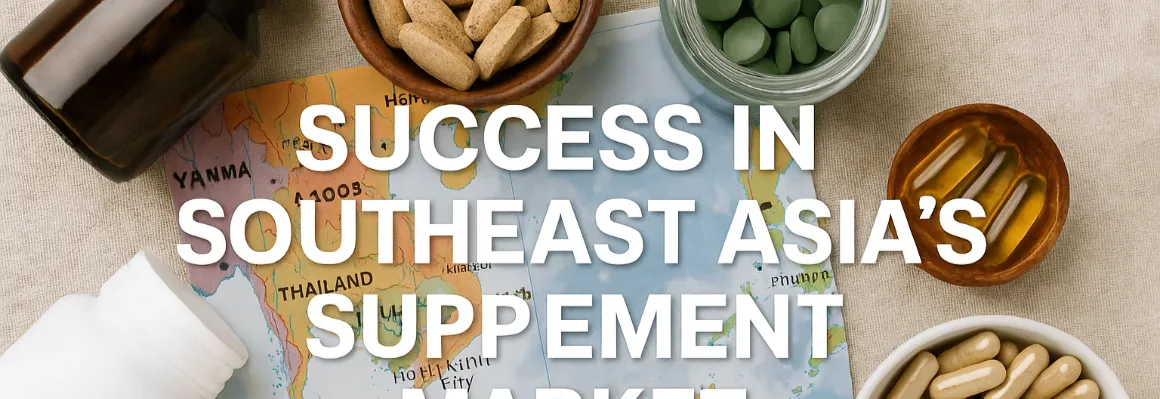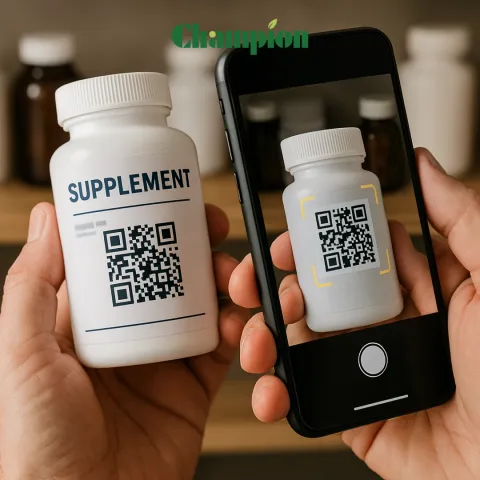Blog
08.Sep.2025
How to Succeed in Southeast Asia’s Booming Supplement Market

Introduction
Southeast Asia is emerging as one of the world’s fastest-growing supplement markets. Countries like Indonesia, Vietnam, Thailand, Malaysia, the Philippines, and Singapore are seeing a surge in consumer health awareness, middle-class spending, and digital retail innovation. In 2024, the ASEAN supplement market reached $11 billion, with a projected CAGR of 8–10% through 2030—making regional entry a top priority for global health brands.Market Size & Growth Drivers
- The region’s dietary supplement market was valued at approximately USD 7.5 billion in 2023, approaching $11 billion in 2024 and forecasted to double by 2030.
- Growth is fueled by:
- Rising health consciousness & preventive wellness
- Expanding urban middle class
- Aging populations seeking bone, joint, and cognitive support
- Pandemic-driven interest in immune, vitamin, and gut products
- Fitness and sports nutrition trends, driven by youth and influencer culture, boost protein powders, amino acids, collagen, supergreens, and detox blends.
Regional Consumer Preferences & Localization
A winning entry strategy hinges on cultural alignment and understanding diverse consumer priorities:- Affordability is key: Southeast Asian buyers are highly price-sensitive, favoring value and efficacy over luxury positioning.
- Local ingredient trust: Traditional botanicals like turmeric, mangosteen, ginseng, Tongkat Ali, and Centella Asiatica rank high—especially formulations blending modern science with trusted folk remedies.
- Beauty-from-within: Supplements for skin, hair, and overall beauty are booming, with female consumers driving demand for collagen, antioxidants, and skin health nutrients.
- Immune & digestive support: Elderly consumers seek proven ingredients for immune function, digestion, and chronic condition support.
Localization Tactics
- Adapt ingredient lists to include popular regional botanicals and feature science-backed claims on packaging.
- Translate marketing and labeling into local languages; showcase traditional and modern benefits for credibility with both young and older generations.
Market Entry Strategies for Foreign Brands
Southeast Asia is unique: market entry success depends on strategic channel selection and regulatory navigation:1. Launch on CBEC-Friendly eCommerce
- Platforms like Shopee, Lazada, and TikTok Shop let foreign brands enter markets rapidly—sometimes without full local registration, ideal for market testing and quick scale.
- Social commerce/live selling is particularly strong in Thailand, Indonesia, and Vietnam; influencer campaigns and peer reviews shape buying decisions.
- Direct-to-consumer models thrive on subscription, auto-replenishment, and interactive engagement (unboxing, reviews, user-generated content).
2. Strategic Distribution Partnerships
- For premium and specialty brands, partnerships with large pharmacy chains, specialty supplement stores, supermarkets, and local wellness experts boost visibility, trust, and trial.
- In-store sampling, expert recommendations, and hybrid retail events are valuable touchpoints for educating and converting consumers.
3. Regulatory Compliance by Market
- ASEAN harmonization efforts exist, but each country retains distinct rules:
- Indonesia’s BPOM: Halal, ingredient & dosage limits, strict labeling
- Singapore’s HSA: Bans common global ingredients, demands detailed submissions
- Malaysia’s NPRA: Flexible, but requires local partner registration and notification
- OEM/ODM partners must provide market-specific documentation (COAs, stability data, Halal/organic certs, ISO 22000/FSSC 22000 validation).champion-bio
Distribution Channel Trends
| Channel | Top Markets | Notes/2025 Trends |
| E-Commerce | All SEA—Indonesia, Vietnam, Thailand | 52% of Asian supplement sales now online; digital tools & content drive engagement |
| Social Commerce | Thailand, Indonesia, Vietnam | TikTok Shop, Shopee Live for flash sales, video testimonials, influencer reach |
| Pharmacies | Malaysia, Philippines, Singapore | Pharmacies and chain stores build trust for premium/elderly segments |
| Specialty Shops | Singapore, Vietnam, Thailand | Growing for beauty-from-within, high-end/sports nutrition, health professionals on staff |
| Supermarkets | Indonesia, Thailand, Malaysia | Mainstream reach, “mass premium,” impulse buys, local expertise |
Opportunities & Challenges
Opportunities
- Rapid expansion and middle-class spending enable accelerated launch for affordable, well-positioned brands.
- Green manufacturing and sustainability resonate; investing in eco-friendly processes and packaging aligns with emerging consumer values.
- Regional partnerships and market research are critical—local experts improve product-market fit and regulatory navigation.
Challenges
- Infrastructure gaps in rural areas can affect delivery and product integrity.
- Regulatory bottlenecks and compliance risks still cause delays for newcomers.
- Highly competitive, fast-moving digital landscape; brands must invest in local influencer relationships and social proof.
Actionable Steps for Success
- Research Local Market Preferences: Survey market needs, health priorities, ingredient trends, and consumer price sensitivity for each country.
- Identify Distribution Mix: Start with eCommerce/social channels for agility, then expand to retail partners for scale and multi-segment reach.
- Localize Formulation & Marketing: Blend traditional and trending actives, use relatable branding, and local language.
- Secure OEM/ODM Support: Partner with manufacturers offering localized regulatory support, flexible MOQs, and tailored documentation.
- Monitor Trends and Data: Build responsive supply chains, marketing, and digital analytics to track consumer habits and competitive shifts.
Frequently Asked Questions (FAQ)
Q: What’s the biggest market in SEA for dietary supplements?A: Indonesia and Vietnam are fastest-growing, but Thailand, Malaysia, Philippines, and Singapore all boast mature digital retail and diverse consumer bases.
Q: Is eCommerce entry possible without local registration?
A: Yes—with platforms like Shopee and Lazada, foreign brands can test demand and scale before full local market registration in many SEA countries.
Q: Which supplement categories are most popular in Southeast Asia?
A: Vitamins, immune support, collagen/beauty, sports nutrition, probiotics, and traditional herbal actives.
Q: What is the key to successful localization?
A: Blend reliable science with locally trusted ingredients, use familiar formats, and speak to cultural health priorities.
Conclusion
Southeast Asia’s supplement market offers breathtaking growth and opportunity. Brands that blend localized insight, digital-first distribution, robust partnerships, and compliance mastery will capture the region’s booming demand and stay ahead of competitors. Success here means adaptive, market-driven strategy—because SEA’s consumers and trends move fast.Want help entering Southeast Asia?
Contact our global strategy team for tailored localization, compliance review, and go-to-market support, ready to unlock this lucrative market in 2025 and beyond.



















